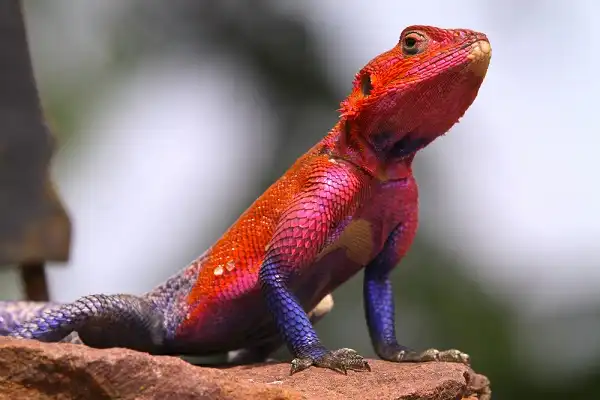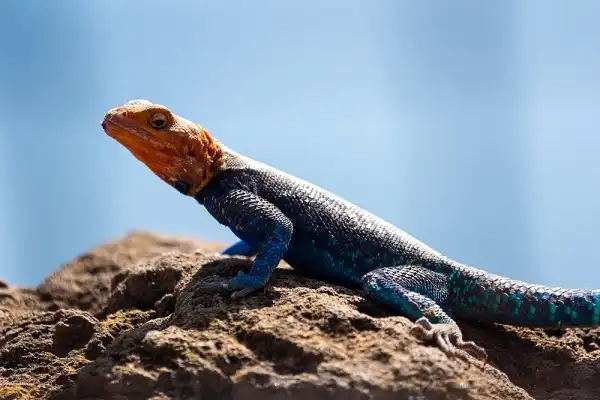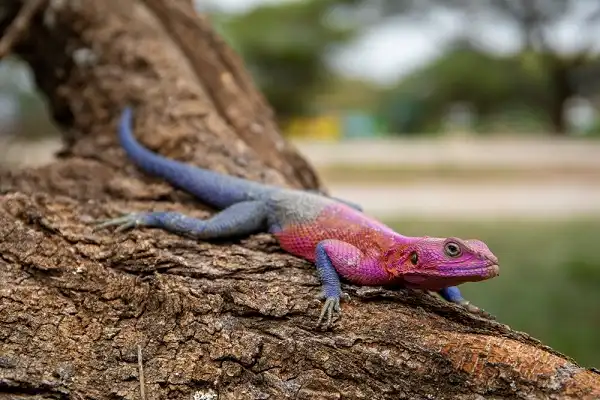Are you looking for an exotic pet to make a unique addition to your family? Look no further than the colorful and active Agama lizard! These fascinating creatures originally hail from Africa, but are now bred and kept as pets around the world. With its vibrant colorations, entertaining behaviors, and interactive nature, the agama lizard has become a popular choice amongst reptile owners everywhere. Read on to learn more about this amazing species – their natural habitats, care requirements, behavior traits, and much more!

Agama Lizard Description
The Agama lizard, also known as the rainbow lizard, is a species of lizard native to Africa. They are small to medium-sized lizards that come in a variety of bright colors, including blue, green, yellow, and red. The males are typically more brightly colored than the females, and during the breeding season, their colors become even more vibrant. Agama lizards are known for their active and entertaining behavior. They are fast-moving and can be quite acrobatic, often jumping from branch to branch. They have a curious and interactive nature, making them a popular choice for reptile owners. It is important to note that agama lizards require regular handling and socialization to ensure they are comfortable around people.
Agama Lizard Habitat
Agama lizards are native to several countries in Africa, including Kenya, Tanzania, and Ethiopia. These lizards thrive in rocky and arid habitats such as savannas and semi-deserts and are often found inhabiting rocky outcrops, cliffs, or similar structures that provide shelter and protection. They can also be found in river beds or near other water sources, such as springs or pools. In the wild, agama lizards are known to be active during the day, basking in the sun to regulate their body temperature. They are also known to burrow in sand or soil to escape the heat and to nestle in crevices for additional protection. Their natural predators include birds of prey, snakes, and other carnivorous animals. Agama lizards have adapted to these harsh environments by developing unique physical and behavioral characteristics. Their stocky, robust bodies, covered by tough scales and spines, allow them to withstand extreme temperatures and protect them from predators. Their long tails help them balance on rocky surfaces and leap from branch to branch. As pets, it is essential to recreate as much of their natural habitat as possible. A large terrarium with suitable rocks, branches, and hiding spaces should be offered, as well as a heat source and access to UVB lighting. The substrate should mimic their natural environment and allow for burrowing opportunities. Additionally, providing a variety of live insects and fresh fruits and vegetables will mimic their natural diet and ensure optimal health and well-being.
Agama Lizard Diet
The agama lizard has a varied diet in the wild, consisting mainly of insects, such as crickets and roaches, and occasionally small mammals and other reptiles. As pets, they should be fed a combination of crickets, dubia roaches, mealworms, and fresh fruits and vegetables. Offering live insects is essential for their well-being, as it stimulates their hunting instincts and provides the necessary nutrients they would normally get in the wild. These insects should be gut-loaded before feeding to ensure that they are also receiving beneficial nutrition. In terms of fruits and vegetables, agama lizards benefit from a variety of options, including leafy greens, such as collard greens and dandelion greens, and brightly-colored vegetables, such as carrots and squash. These should be chopped into appropriate sizes and offered in a shallow dish or on a feeding platform. It is important to note that agama lizards have a tendency to overeat, leading to obesity and other health issues. To avoid this, feed them appropriately sized portions that they can finish within 10 to 15 minutes. Feed juvenile agama lizards every day, while adults can be fed every other day. An inadequate diet can lead to health problems, including metabolic bone disease, digestive issues, and obesity. Therefore, it is important to provide a balanced diet and ensure their food is dusted with calcium and vitamin D3 supplements as needed.

Agama Lizard Size
The agama lizard, also known as the rainbow lizard, is a fascinating species that can reach a size of up to 30 centimeters in length, including their tail. As with most reptiles, males tend to be larger than females, with some males reaching up to 40 centimeters in length. Their stocky, robust bodies are covered in tough scales and spines that protect them from predators and allow them to withstand extreme temperatures. These physical characteristics, coupled with their ability to store fat in their tails during periods of scarcity, make them well-suited to surviving in harsh desert environments. In terms of weight, agama lizards tend to be relatively light, with the average adult weighing in at around 50-60 grams. However, captive agama lizards can sometimes become overweight if not provided with a balanced diet and adequate activity. Interestingly, the coloration of agama lizards can vary significantly depending on their mood, environment, and social status. For example, males will often display bright colors, such as reds, oranges, and blues, when vying for a female’s attention or defending their territory. Females and juveniles, on the other hand, tend to have more muted colors, such as browns and grays, that help them blend in with their surroundings.
Agama Lizard Lifespan
Agama lizards have an average lifespan of approximately 8 to 12 years in captivity, although some have been known to live for up to 20 years. Their lifespan in the wild is often shorter due to predation and other environmental factors. The lifespan of agama lizards can be influenced by various factors such as diet, temperature, and habitat. In general, providing a healthy and balanced diet, adequate temperature, and a suitable environment can help prolong their lifespan. In captivity, agama lizards can thrive with appropriate care, a balanced diet, and regular exercise. However, it is important to note that they require a significant commitment from their owners in terms of time, effort, and resources. It is also worth noting that some species of agama lizards, such as the African painted agama, have been listed as near threatened due to habitat loss and over-collection for the exotic pet trade. Therefore, it is important to research and purchase agama lizards from reputable breeders and avoid contributing to the illegal trade of these fascinating creatures.
Agama Lizard Behavior
Agama lizards, also known as rainbow lizards, are fascinating creatures not only because of their unique physical characteristics but also because of their interesting behavior. These reptiles are known to be active during the day, spending most of their time basking in the sun to regulate their body temperature. They can often be observed climbing rocks, basking on tree branches, or burrowing in the sand. Agama lizards are territorial and will defend their space from other lizards, especially males. Males will often exhibit aggressive behavior during the breeding season, displaying their bright and vibrant colors to attract a mate while also fighting off other competing males. Females, on the other hand, tend to be more docile and will often display submissive behavior towards males. Interestingly, agama lizards have also been observed using visual displays to communicate with each other. For example, when a male is courting a female, he will perform a series of head-bobbing movements and will often extend his dewlap, a flap of skin under the chin, to display his bright colors. Females, in turn, will often respond with a similar display or by changing their body position to indicate their willingness to mate.

Agama Lizard Speed
Agama lizards are not only known for their colorful appearance and fascinating behavior but also for their impressive speed. These reptiles are capable of running at high speeds for short bursts, making them efficient hunters and agile predators. Agama lizards use their powerful legs to propel themselves forward, and their long tails to balance and steer their movements. They can reach speeds of up to 20 miles per hour (32 km/h), making them one of the fastest lizard species in the world. Interestingly, agama lizards have also been observed using their speed to evade predators or competition from other lizards.
They are known to use their quick reflexes and agility to dodge attacks or catch their prey by surprise. Their speed is not only beneficial for hunting and defense but also for thermoregulation. Agama lizards will often run to warmer or cooler areas to regulate their body temperature, as they require a specific range of temperatures to function optimally. In captivity, it is important to provide agama lizards with ample space and opportunities for exercise to ensure their physical and mental well-being. This can include providing them with access to climbing structures, basking platforms, and large enclosures that mimic their natural habitat.
Agama Lizard Hunting
Agama lizards are impressive hunters due to their incredible speed and agility. They use their sharp eyesight to detect potential prey and will quickly pursue it with remarkable speed. They generally hunt in the early morning or late afternoon when the temperature is cooler, as this is when their prey is most active. This lizard’s diet primarily consists of insects, including grasshoppers, crickets, and beetles. They are also known to eat spiders, small lizards, and even small birds. Their speed and agility make them efficient predators and aid them in catching their prey with a quick bite from their sharp teeth. Agama lizards often use visual displays to lure in their prey.
They have been observed performing a series of head-bobbing movements, similar to their behavior during courtship. This movement, in addition to the display of their brilliant colors, attracts their prey closer, giving them the perfect opportunity to strike. These lizards also use their speed to evade predators. They have excellent reflexes and are able to outrun many predators, including snakes and birds of prey. Additionally, they can use their long tails to change direction quickly, making it harder for predators to catch them.
Agama Lizards Predators and Threats
Agama lizards, with their colorful appearance and impressive speed, may seem invincible, but just like any other creature, they face threats and predators in their natural habitats. Understanding these natural predators and potential threats can help pet owners provide optimal care and protection for their beloved reptiles. In the wild, agama lizards face a myriad of natural predators, including birds of prey, snakes, and larger predators such as monitor lizards and other carnivorous mammals. Young agamas are particularly vulnerable to predation, and new hatchlings may be eaten by a variety of predators in their first few months of life.
Climate change, which can lead to extreme weather conditions and fluctuations in temperature, can also negatively affect agama populations. Changes in temperature can disrupt breeding patterns, alter food availability, and impact the ability of agama lizards to regulate their body temperature. In captivity, agama lizards may also face a variety of potential threats and hazards. Poor nutrition, inadequate or inappropriate housing, and lack of proper husbandry can all negatively impact the health and well-being of agama lizards.

Agama Lizards Reproduction
Agama lizards reproduce via sexual reproduction, with males and females engaging in courtship rituals to attract mates. Female agama lizards are capable of producing multiple eggs at once and may lay up to 4 clutches of eggs per year. The eggs take around 3 to 6 weeks to hatch, depending on the temperature and humidity levels in the environment. Young agama lizards reach sexual maturity within 2 years, although they will not start breeding until they have reached a certain size. Once bonded, male and female agamas often form monogamous pairs and stay together for many years. Agamas are also known to exhibit parental care, with males defending their territories against intruders and females tending to the young during hatching season.
Conclusion
Agama lizards are fascinating creatures with remarkable speed, agility, and hunting capabilities. They use their speed to catch prey, evade predators, and regulate their body temperature. When kept in captivity, it is important to provide them with ample space and opportunities for exercise as well as a balanced diet. With the right care and an optimal environment, agama lizards can thrive in captivity and make excellent pets!
Frequently Asked Question

